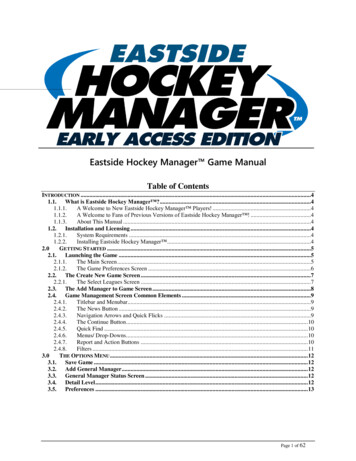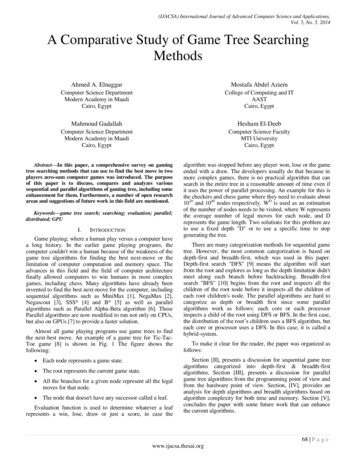
Transcription
Big Game ReviewTeamINITIAL DRAFT 2022 ARCHERY ELK PROPOSALMARCH 16, 2021
Synopsis of Past ManagementProcess 1979 Statewide Archery Season Moved archery from a few select units Created current season framework in 19831994 Elk Plan Established structure that led to changes in rifle seasons Framework for all changes to rifle seasons2003 Archery Review Committee Issues discussed Equity Overcrowding Biologists concerns with biological/management issues2014 Archery Review Public Advisory Committee Review criteria for either sex hunts Portability (controlled tag valid in general season)
Previous Archery ProposalBenefits Consistent approach to deer and elk archery season Eliminates potential for additional change in the futureIssuesFrom hunter opinion survey, 2020 Lack of any general season opportunity in eastern Oregon More restrictive than rifle May not be necessary in all units
Summary of Concerns Expressedto ODFW in 2020 Change not needed biologically Opportunity to hunt every year Ability to hunt while building preference points Desire to engage new hunters in archery Impacts from fire closures
Goals of Regulation Team ArcheryProposal Allow for district biologists to adjust tags across all user groups inorder to meet elk plan objectives Provide ability to address hunter crowding in units with high hunterdensities and hunter complaints Provide vehicle for biologists to address elk disturbance in areas withdocumented elk movement in response to start of elk season Allow for equitable utilization of biological resource Create consistent regulations that are easy to understand andexplain to public Address preference point creep in eastern Oregon
Team Approach to RevisitingProposal Looked at various concepts proposed for archery changes in thepast Choose your weapon Zones Controlled Hunts No Change Weighed different concepts against the goals of the project Assessed each concept against comments received in 2020
Elk Management Objectives Elk planning process First elk Management Objectives (MO) set in 1981 First elk plan adopted in 1992 Plan revised 2003 MO’s last reviewed in 2016 Public work groups, Commission approved Factors considered to set MO’s Prevent serious depletion of indigenous wildlife Provide optimum recreational and aesthetic benefits Maintain populations at levels compatible with primary uses of the land Not set on carrying capacity Must weigh social tolerance
Elk Management Objectives Population MO’sNumber of wintering animals in each wildlife managementunit Managed through antlerless harvest Measured by multiple methodsoTrendoAerial surveysoModelsDamage harvest is conducted regardless of population MOstatus
Elk Management Objectives Bull ratio MOProportion of bulls within population Measured as observed bulls per 100 cows post-hunting seasonoPlan dictates goal: 10, 15 or 20oThe higher the bull MO the less hunting opportunity in a unitMeasured by spring composition surveysLink to current elk planhttp://www.dfw.state.or.us/wildlife/management plans/docs/ElkPlanfinal.pdf Link to current management agement bjectives%20-%202016.pdf
Data to Identify Units for Proposal Bull Ratio Management Objective (MO) Issues Archery Harvest 35% Units lower than 75% of MO, Missed MO 3 of 5 yearsCompare branch bull harvest of general archers torifle seasons with bag limit of “one elk” or “one bull”Limits ability to address concerns through rifle cutsRifle Harvest Concern Greater than 20% decrease in controlled rifle tagsover last 25 years
Units Noted with MO IssuesUnits Below Bull MOUPPER KE RIVERMINAMIMNAHAPINE CREEKKEATINGWARNERUnits with 35% of Branch BullHarvest in Archery SeasonBEULAHCATHERINE CREEKDESOLATIONFORT ROCKGRIZZLYHEPPNERIMNAHAINTERSTATEKEATINGKLAMATH FALLSMALHEUR RIVERMURDERERS CREEKNORTHSIDEPINE CREEKSILVIESSTARKEYSUMPTERUKIAHUnits with Decrease in RifleHarvestPAULINABEULAHSTARKEYFORT RDERERS CREEKSUMPTERFOSSIL
Rationale for 35% Harvest AllocationAny harvest system where over 1/3 ofthe harvest is in a general seasoncreates difficulty for managers inmeeting MO Hunter survey data in 2020 showedthat 34% of all hunters in Oregonwould be interested in hunting witharchery equipment Recognition that while 21% of allhunters report preferring to hunt witha bow, younger hunters (18-34 yearsold) have a higher affinity for archery,28%
Long Term Decline in Opportunity With shift to controlled hunts, andreduction in antlerless hunts overallrifle opportunity has decreased 57%since 1995 In same time period, archeryparticipation has increase 60% In many units rifle harvest cuts bybiologists have led to archeryharvest increases, offsettingpopulation response to the rifle tagcuts
Units Team Proposed for ControlName# of yearsin last 55 year ave. missedBull MO% of MOBull MOAve # ofgeneralarchers% Branch# Branchbullbull rifle harvest 70%5164544361%SNAKE 4%558928836%PINE es unit with general spike-only any weapon tagPopulation data is 2015-2019, Harvest data is from 2016-2019, excluding 2018 due to data integrity issue
Additional Units Proposed for ControlBased on ODFW District InputName# of years5 year ave. in last 5% of BullmissedMOBull MOAve # ofgeneralarchers# Branch % Branchbull rifle bull harvesttagsby 20112937%SILVIES99%293797934%CATHERINE 5%1150243157%*Denotes unit with general spike-only any weapon tagPopulation data is 2015-2019, Harvest data is from 2016-2019, excluding 2018 due to data integrity issue
Concepts Analyzed by ODFWRegulation Review Team Choose Your Weapon Pros Provides advantage for hunters that are exclusively archers Any controlled hunt is essentially choose your weaponCons Does not address harvest management for districts Does not ensure reduction in disturbance/displacement of elk Does not create consistent regulations Does not provide maximum and equitable opportunity
Concepts Analyzed by ODFWRegulation Review Team General Zones (General season grouping of twoor more units) Pros Provides over the counter opportunity for archers Would refine hunter density data Provides flexibility in case of fire eventCons Does not address unit specific harvest management Does not reduce disturbance/displacement of elk Does not create consistent regulations Does not allow for equitable utilization of resource
Concepts Analyzed by ODFWRegulation Review Team Controlled Zones Pros Allows flexibility in case of fire restrictions Would refine hunter density data Improves ability to manage unit harvestCons Reduces archery opportunity for entire zone when any unit withinthe zone needs harvest reduction to meet MO’s Does not ensure reduction in disturbance/displacement of elk Does not create consistent regulations
Concepts Analyzed by ODFWRegulation Review Team Controlled Units Pros Allows for equitable allocation and harvest management Allows for districts to manage crowding/displacement in units with need Consistent with current regulations Consistent population management between all users Assists with point creepCons Some units may not be drawn annually by a hunter Less dynamic in addressing fire events Fewer general season units to hunt annually while building points
Concepts Analyzed by ODFWRegulation Review Team Current General Archery Season Pros Understood by hunters Maximum opportunity for archersCons Does not address harvest management for districts Does not ensure reduction in disturbance/displacement of elk Maintains current hunter densities in crowded units Does not create consistent regulations Does not allow for equitable utilization of resource
Initial DraftProposalEach tag- West General, EastGeneral and Unit Controlled wouldbe a stand alone, non-transportableopportunity
2020 General Season Archery HunterControlled Hunt Choices Most archers do notparticipate in controlledhunt draw Rifle hunters do notcomprise a largeamount of annualgeneral season archers17%65%14%4%Archery HuntRifle HuntPoint SaverDid Not Apply
2020 General Season Archer Point Totals1200010000 4100 archers(12.9%) had- 7 ormore points No unit-wide huntfor archery or rifle isprojected to needmore than 7 points,except WallaWalla, Wenahaand Mt er of 2020 General Season Archers17181920212223242627
Controlled Hunt Tag AllocationFramework for 2022 In units currently over population MO and meeting bull MO targets Tag numbers similar to 5 year participation average One elk bag limit for all or part of tag allocationIn units currently meeting population and bull MO targets Tag numbers similar to 5 year participation average One bull bag limitIn units below bull MO Reduce harvest to achieve MO. Work to allocate harvest based on35% archery branch bull harvest
Potential Effects of Non-ResidentQuota Oregon has a 5% non-resident cap on all controlled hunts There is no cap for general seasonsLicense Type- Non-Resident 2020Total Non-ResidentsAnnual Hunting LicenseElk - 200 Series Controlled Hunt ApplicationElk - Controlled Hunt (200 Series) TagElk - Eastern Oregon Rocky Mountain Second Season TagElk - General Season Antlerless Damage TagElk - General Season Archery TagElk - Premium Controlled Hunt TagElk - West Cascade Tag145007293153619327222682101YearGeneral Season ArchersTotal Non-Resident5% Cap*Total 681597671* 5% cap represents total non-resident tags if all tags were controlled or limited** Total reduction assumes all non-residents applied for a controlled or limited hunt
Fire Effects to Archery Season Current policy addresses options provided to huntersbased on extent of opportunity lost Hunters may choose to hunt general season rather thancontrolled hunt prior to start of season Department navigated multiple options during 2020hunting seasons
Development of Final Proposal forCommission Review Ability to adjust harvest to meet elk management objectives Provide equitable opportunity for all hunters Have a regulation that is easy to explain to new and existinghunters Take all public and sport group input into development offinal proposal Multiple alternate proposals or modifications to currentproposals have been received so far from sports groups andthe public
Factors Considered During FinalProposal Development Ability to Address Bull MO Concerns Still Provide General Season Opportunity in both East and West Greater Control over Harvest by District Biologists Hunter Crowding/Density Elk Displacement/ Disturbance Equitability of Harvest Between all Users Potentially Affect Point Creep
Initial Draft ProposalUnitFive Year Archery HunterAverageHeppnerUkiahMurderer CreekNorthsideDesolationN. SumpterCatherine CreekStarkeyMinamImnahaSnake RiverKeatingPine CreekW BeulahN. Malheur RiverSilviesUnits Below Management 24511597*688*932* Total Unit HuntersAdditional FW.Wildlifeinfo@state.or.us
Synopsis of Past Management Process 1979 Statewide Archery Season Moved archery from a few select units Created current season framework in 1983 1994 Elk Plan Established structure that led to changes in rifle seasons Framework for all changes to rifle seasons 2003 Archery Review Committee Issues discussed Equity Overcrowding Biologists concerns with biological/management issues











